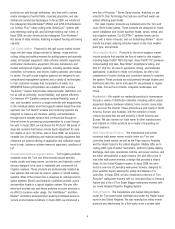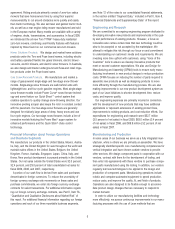Toro 2009 Annual Report Download - page 19
Download and view the complete annual report
Please find page 19 of the 2009 Toro annual report below. You can navigate through the pages in the report by either clicking on the pages listed below, or by using the keyword search tool below to find specific information within the annual report.Korea. Our net sales outside the United States were 32.0 percent,
We face intense competition in all of our product lines
32.4 percent, and 29.0 percent of our total consolidated net sales
with numerous manufacturers, including from some that
for fiscal 2009, 2008, and 2007, respectively. International markets
have greater operations and financial resources than us.
have, and will continue to be, a focus for revenue growth. We
We may not be able to compete effectively against
believe many opportunities exist in the international markets, and
competitors’ actions, which could harm our business
over time we intend for international net sales to comprise a larger
and operating results.
percentage of our total consolidated net sales. Several factors,
Our products are sold in highly competitive markets throughout the including weakened international economic conditions, could
world. Principal competitive factors in our markets include product adversely affect such growth. Additionally, the expansion of our
innovation, quality and reliability, product support and customer existing international operations and entry into additional interna-
service, pricing, warranty, brand awareness, reputation, distribu- tional markets require significant management attention and finan-
tion, shelf space, and financing options. We compete in all of our cial resources. Many of the countries in which we sell our prod-
product lines with numerous manufacturers, some which have sub- ucts, or otherwise have an international presence are, to some
stantially greater operations and financial resources than us. As a degree, subject to political, economic, and/or social instability,
result, they may be able to adapt more quickly to new or emerging including cartel-related violence. Our international operations
technologies and changes in customer preferences, or to devote expose us and our representatives, agents, and distributors to
greater resources to the development, promotion, and sale of their risks inherent in operating in foreign jurisdictions. These risks
products than we can. In addition, competition could increase if include:
new companies enter the market or if existing competitors expand
•
increased costs of customizing products for foreign countries;
their product lines or intensify efforts within existing product lines.
•
difficulties in managing and staffing international operations and
Our current products, products under development, and our ability increases in infrastructure costs including legal, tax, accounting,
to develop new and improved products may be insufficient to and information technology;
enable us to compete effectively with our competitors. Internation-
•
the imposition of additional U.S. and foreign governmental con-
ally, our residential segment products typically face more competi- trols or regulations; new or enhanced trade restrictions and
tion where foreign competitors manufacture and market products in restrictions on the activities of foreign agents, representatives,
their respective countries. We experience this competition primarily and distributors; and the imposition of increases in costly and
in Europe. In addition, fluctuations in the value of the U.S. dollar lengthy import and export licensing and other compliance
may affect the price of our products in foreign markets, thereby requirements, customs duties and tariffs, license obligations, and
impacting their competitiveness. Pricing volatility has also become other non-tariff barriers to trade;
an increasingly important competitive factor for many of our prod-
•
the imposition of U.S. and/or international sanctions against a
ucts. We may not be able to compete effectively against competi- country, company, person, or entity with whom we do business
tors’ actions, which may include the movement by competitors of that would restrict or prohibit our continued business with the
significant manufacturing to low cost countries for significant cost sanctioned country, company, person, or entity;
and price reductions, and could harm our business and operating
•
international pricing pressures;
results.
•
laws and business practices favoring local companies;
•
adverse currency exchange rate fluctuations;
A significant percentage of our consolidated net sales
•
longer payment cycles and difficulties in enforcing agreements
are generated outside of the United States, and we and collecting receivables through certain foreign legal systems;
intend to continue to expand our international
•
difficulties in enforcing or defending intellectual property rights;
operations. Our international operations require and
significant management attention and financial
•
multiple, changing, and often inconsistent enforcement of laws,
resources, expose us to difficulties presented by rules, and regulations, including rules relating to environmental,
international economic, political, legal, accounting, and health, and safety matters.
business factors, and may not be successful or produce Our international operations may not produce desired levels of
desired levels of net sales. net sales or one or more of the factors listed above may harm our
We manufacture our products in the United States, Mexico, Austra- business and operating results. Any material decrease in our inter-
lia, the United Kingdom, and Italy for sale throughout the world and national sales or profitability could also adversely impact our oper-
maintain sales offices in the United States, Belgium, the United ating results.
Kingdom, France, Australia, Singapore, Japan, China, Italy, and
13
























